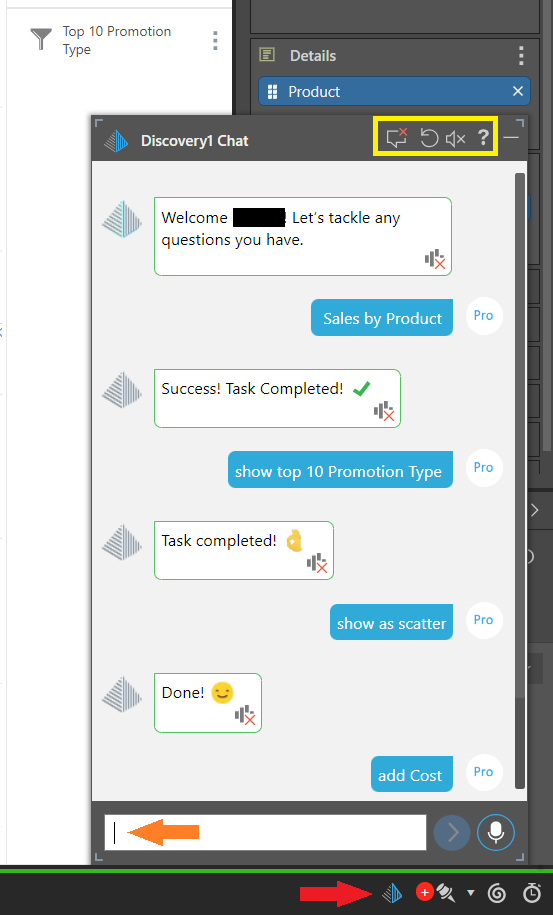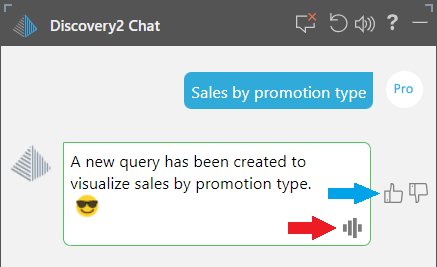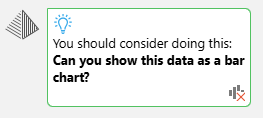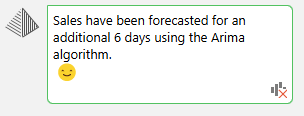The Pyramid Chatbot is a simple interactive panel lets you ask analytical or other questions in natural language using text or speech, and receive a response that creates or changes your discoveries, calculations, presentations, and publications. The idea is that you don't have to painstakingly build or change your visual, but can just "say" (or type) what you want to include, exclude, or change, and Pyramid will make the changes for you. You can then interact with the questions and answers in the panel to build up or improve your content.
At design time, Pro or Analyst users build and analyze their discoveries, calculations, presentations, and publications using the Chatbot in Discover, Formulate, Present, and Publish Pro and Lite. At runtime, users can interact with any presentations they have access to using the Chatbot; they can show more data, manipulate content (limiting it to a particular time period or grouping by location, team, or customer's gender), or otherwise explore the visual.
Note: If your administrator has chosen to use the internal Portable Language Model (PLM), Pyramid Internal, then the Chatbot is only enabled at Design time in Discover and at Runtime in Discover and Present. For more information, see Multiple LLM Engines.
Chatbot pop-up
The Chatbot is a pop-up that allows users to say or write a sequence of questions in natural language that are interpreted automatically and trigger changes to the currently selected visual.

Note: The red arrow points to the Open Chatbot button, which is used when you are building or analyzing data visuals at design time. If you want to open the Chatbot at runtime, you need to run your visual and open the Chatbot from its panel tools.
Open the Chatbot
How you open your Chatbot depends on whether you are a Designer (a Pro or Analyst user building discoveries, calculations, presentations, and publications), or you are viewing and interacting with a presentation or discovery at runtime.
Note: If your administrator has chosen to use the internal Portable Language Model (PLM), Pyramid Internal, then the Chatbot is only enabled at Design time in Discover and at Runtime in Discover and Present. For more information, see Multiple LLM Engines.
Select your Model
If you are building your Publication or Presentation in Publish or Present, you need to select the Data Source as the first step. The available models are displayed in the Chatbot for selection:
- Select a Model: You are initially prompted to select a model. Previously used models are displayed by default.
- More Models: If required, more models can be accessed by clicking this option. You can then select the model from your recent, favorites, or explorer options.
Tip: You can change which model is selected by typing the keyword \data into your Chatbot and selecting the required model.
Chat Session Options
At the top of the panel are a number of options that relate to your current session (yellow, above).
- Clear Chat Messages: Clears all of the previous chat messages from the Chatbot. This doesn't affect the visual.
- Reset: Resets the chat session and the visual back to its original state.
- New Query: (Runtime only) Restarts the chat with a new blank query. All hierarchies and measures are removed from the visual, allowing you to build a new query from scratch.
- Unmute: Mutes or un-mutes the speech facility used by the Chatbot. Muting the Chatbot means that you will not receive audible responses to your prompts.
Tip: You can choose whether to mute or unmute your Chatbot by default using the Chatbot Audio Response option in your User Defaults.
Ask a question
The text field (orange arrow) is where you ask your question (NLQ) or "prompt". You can either type your question and press Enter or click the Arrow button, or you can hold down the Microphone button and just say your question into your microphone. In the latter case, Pyramid uses its speech-to-text facility to show your spoken question in the Chatbot as if you had typed it.
Note: The Chatbot lets you ask multiple questions, and applies the changes associated with each of your questions in a cumulative way. Each additional question adjusts the previous query, regardless of whether the original query was generated by the Chatbot or drawn manually by the user dropping measures into the drop zones.
Wildcards and keywords
As you type, the Chatbot attempts to recognize any hierarchies or measures that you may be referring to, and offers you a list of matches to select from.
You can also use wildcard characters to show different options in the current model if you don't know what to type. This is especially useful if you don't know the exact name of the item you're looking for, or if you want to prompt a particular Chatbot command. Options include:
\- show options - opens a list of available predefined commands.\measuresor\m- shows all measures in the model.\hierarchyor\h- shows all hierarchies in the model.\layout- Present and Publish only - changes the available layout for your storyboard.\data- Present and Publish only - changes the model for your storyboard.\redraw- Discover only - refreshes and redraws the visual. You should use redraw if you altered your visual and you want the AI to suggest the best visual type to use. For more information about this keyword, see NLQ: Visualizations.
Restart
The keywords reset / restart / start over can be used to reset the Chat session and the query. The same function can be performed by clicking the button in the top of the chat panel.
In Discover, you can type the keyword print either on its own, or as part of another prompt (for example, "change to a pie then print"), to open the Print & Export dialog and print or export the report. For more information, see Printing in Discover.
Save
In the Discover, Formulate, Present, and Publish apps, you can type the keyword save to save the currently open file. If the file has not been saved previously, the Save As dialog opens so that you can specify a name and other details for your file, and choose where to save it. Otherwise, the file is simply saved. For more details, see: Saving Content.
Recommendations and "type ahead"
As you type your question, the "type ahead" functionality offers you options and suggestions as follows:

Measures and hierarchies
After you have typed two characters into the text field, you are offered any measures or hierarchies from the model that match your entries. Selecting these items ensures that your query includes exactly the selected measure or hierarchy.
User suggestions
You are also offered full queries in the following circumstances:
- If you previously ran a query against the same model, you can select that query from the drop-down list of options. Queries of this type are prefixed with a "user" icon (blue arrow above).
- If another user previously ran a query against the same model, you can select that query from the drop-down list of suggestions. Queries of this type are prefixed with a "re-use" icon (orange arrow). This suggestion list is a list of the most popular questions for the current model that match the types of questions you are asking in the session so it can give you a good sense of the sort of information people commonly look for in the current model.
Note: Suggestions are only shown if there are enough questions in the history and there are matches given your line of questioning.
Auto Model Suggestions
Once a model is processed, suggestions for questions to be asked will be provided automatically by the LLM. The AI driven list is based on typical questions people usually ask for the type of data set presented. They are only generated when your model is processed.
These suggestions are prefixed with a Pyramid icon (yellow arrow) and can be selected in the same way as other suggestions.
These are only generated if Analytic Suggestions is enabled by your administrator in the Admin Console.

Copy previous question
After you have sent a request, you can use the Copy icon (opens on hover) to copy it from the session. This is useful if you want to repeat a question or make minor adjustments to it before running it again, perhaps after you have reset the Chatbot.

Responses
Once your question has been processed, a response is presented in the Chatbot. If you have the sound for your Chatbot un-muted, the response is also spoken aloud.

Play or Replay the Audio
You can replay the spoken response by clicking the audio symbol (orange arrow).
This works even if the audio was muted (as in the preceding example). In this case, selecting this option un-mutes the audio and plays the audio response too.
"Like" the Result
If your prompt was the first question asked in the Chatbot and it created a visual on an empty canvas, you can use the thumbs up and thumbs down icons to like or dislike the result (blue arrow). Liking a result promotes the associated question up the list of type ahead suggestions the next time you open the same model.
Note: If this comment has likes from different users, it is suggested globally; that is, to other users of the same model.
Next Suggestion
If you are building a discovery or exploring a visual in a presentation at runtime, the Chatbot may suggest a "next action" to improve your current visual. The underlying LLM analyzes your chat content and suggests options such as adding a filter (as in the example above, green arrow), changing the visualization type used (as in the example below), applying a forecast or other analysis function, explaining the content, and so on.

If you agree that the suggestion is relevant and will improve your visual, you can apply the suggestion by clicking on the Bold Text in the response. That text is then sent to the Chatbot as the next request in your chat.
Explain the Result
If you use the Chatbot to apply outlier, clustering, regression, forecasting, or fill blanks calculations to the query, Pyramid auto-generates a text explanation in the results panel. This explains how the calculation was evaluated and which algorithm was used:

- Click here for more information about "explaining the result"
Move, resize, close, and open
- Select the Chatbot by its title bar to drag it around the canvas.
- Minimize the Chatbot using the button on the top-right.
- Re-open / maximize the Chatbot using the Open button.
- Resize the Chatbot by clicking and dragging the handle at its bottom-right.
Change view
Design time only. When you move between the tabs at the bottom of your page, the Chatbot remains open but changes context. Its content always reflects the history associated with the tab that is currently open.
When you open a tab for an app that does not support the Chatbot; for example, when you click a Model tab; the Chatbot closes. It reopens when you tab to another app that does support the Chatbot.
Note: If your administrator has chosen to use the internal Portable Language Model (PLM), Pyramid Internal, then the Chatbot is only enabled at Design time in Discover and at Runtime in Discover and Present. For more information, see Multiple LLM Engines.
Keyboard Shortcuts
While in the chat text box, different shortcuts are available using the arrow keys:
- Arrow left and right - Moves the cursor through the current text in the text box in the direction signified by the arrow.
- Arrow up and down - When suggestions or type ahead values are shown in the text box, the up and down keys allow you to navigate the list.